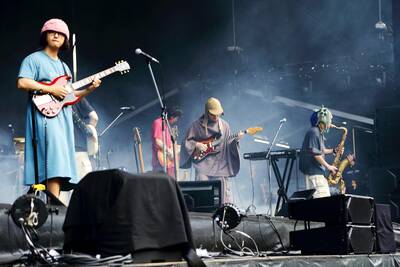Yingge Town Artisan
Pottery stores along Yingge Old Street (鶯歌老街) no longer sell teapots made by Tseng Tsai-wan (曾財萬) these days.
“They’re too expensive. A single teapot fetches up to NT$70,000 these days,” he says, gesticulating with his hands and sending one of the teapots crashing to the ground.

Photo: Paul Cooper, Taipei Times
Momentarily distracted, Tseng, also known as Master Wan (阿萬師), waves a hand, and his son comes forward to sweep up the pieces.
Tseng is still making teapots at 84. Born into poverty, and missing out on a proper education during the instability in the immediate aftermath of the war, he started working in ceramics in his early teens, but only found success when he started making fake Chinese antiques. It was only when collectors became wary of buying antique teapots due to the great number of fakes that he started developing his own.
Today, he is known for his zhuni (cinnabar clay) pear skin teapots (朱泥梨皮壺), using a special clay blend that produces the pear pip skin effect — white grain specks on the surface — during the firing process.

Photo: Paul Cooper, Taipei Times
These pear pip skin teapots are prized for the extra sweetness they give to the tea brewed in them. Over the years, the tea will gradually stain the white grains yellow. Collectors call these huangjinzi (golden grains).
Tseng had a hard upbringing. Born in Yingge during the Japanese colonial era, his family was so poor that he didn’t attend school from age eight to 10. He remembers the Japanese cops extorting money from his father, and beating him when he couldn’t pay. The family eventually fled to Taichung, living in pig pens or cow sheds.
His sister died aged two.
“She died because my father only looked after the boys,” Tseng said.
STORAGE JARS TO TEAPOTS
Tseng started studying how to make ceramics, to bring in some money. He made braziers, medicine storage jars and large water pots, and much later, he turned his hands to teapots after the plastics industry decimated demand for pottery storage jars.
“I was the first person to make teapots by hand. I was also the first person in Taiwan to make the pear skin teapots,” he says.
An unknown, he discovered he couldn’t cover his costs selling these under his own name. He decided the only way was to make fakes of antique Chinese Shantou pots (汕頭壺).
Tseng says making fakes during the 1980s was very lucrative, and he could get NT$5,000 or NT$6,000 for a single fake antique teapot, NT$8,000 for a larger one.
He became so good at making fakes indistinguishable from the authentic antiques that collectors became wary of buying antiques after he exhibited three of his teapots at an exhibition at the Yingge Ceramics Museum. After that, he had to sell his teapots to dealers in Kaohsiung and Pingtung.
Kujiang District (堀江區) near the Port of Kaohsiung was known for selling antiques — and smuggled goods.
“They would sell anything. So, I took my stuff there.”
After a dealer reneged on a big order for fake antique teapots, Tseng decided it was time to sell under his own name. He started getting a reputation for making high quality teapots.
In the 1990s, a descendant of Banciao’s wealthy Lin (林) family offered NT$5 million for all the teapots he could make. He turned him down.
“His idea was that I hadn’t been making teapots all that long, and after I passed away he would make a lot of money selling them to collectors,” Tseng said.
All his work now is commissioned. He has more orders than he can cope with, and is not taking any more this year.
He says that money isn’t all that important to him, and that now he can do what he pleases. “Had I been chained to making pots for that one guy, I wouldn’t have that freedom. And without that freedom, I wouldn’t be happy.”
Next month, Yingge Artisan looks at painter Chang Sung-shan (張松山).
Yingge Town Artisan is a monthly photographic and historical exploration of the artists and potters linked to New Taipei City’s Yingge Town.

No one saw it coming. Everyone — including the Chinese Nationalist Party (KMT) — expected at least some of the recall campaigns against 24 of its lawmakers and Hsinchu Mayor Ann Kao (高虹安) to succeed. Underground gamblers reportedly expected between five and eight lawmakers to lose their jobs. All of this analysis made sense, but contained a fatal flaw. The record of the recall campaigns, the collapse of the KMT-led recalls, and polling data all pointed to enthusiastic high turnout in support of the recall campaigns, and that those against the recalls were unenthusiastic and far less likely to vote. That

Behind a car repair business on a nondescript Thai street are the cherished pets of a rising TikTok animal influencer: two lions and a 200-kilogram lion-tiger hybrid called “Big George.” Lion ownership is legal in Thailand, and Tharnuwarht Plengkemratch is an enthusiastic advocate, posting updates on his feline companions to nearly three million followers. “They’re playful and affectionate, just like dogs or cats,” he said from inside their cage complex at his home in the northern city of Chiang Mai. Thailand’s captive lion population has exploded in recent years, with nearly 500 registered in zoos, breeding farms, petting cafes and homes. Experts warn the

A couple of weeks ago the parties aligned with the People’s Republic of China (PRC), the Chinese Nationalist Party (KMT) and the Taiwan People’s Party (TPP), voted in the legislature to eliminate the subsidy that enables Taiwan Power Co (Taipower) to keep up with its burgeoning debt, and instead pay for universal cash handouts worth NT$10,000. The subsidy would have been NT$100 billion, while the cash handout had a budget of NT$235 billion. The bill mandates that the cash payments must be completed by Oct. 31 of this year. The changes were part of the overall NT$545 billion budget approved

Before performing last Friday at Asia’s bellwether music festival, Fuji Rock in Japan, the Taiwanese indie band Sunset Rollercoaster (落日飛車) had previously performed on one of the festival’s smaller stages and also at Coachella, the biggest brand name in US music festivals. But this set on Fuji Rock’s main stage was a true raising of the bar. On a brilliant summer’s evening, with the sun rays streaming down over a backdrop of green mountains and fluffy white clouds, the performance saw the Taiwanese groovemasters team up with South Korean group Hyukoh, with whom they’ve formed a temporary supergroup called AAA